12 Remote Work Tips to Keep You Productive, Happy and Healthy
Updated 19 July 2022 (Published 10 June 2020) by Miles in Business Tips
In this article, I will take you through a dozen tips on how to successfully work from home, or from anywhere, such as your favourite café, local beach or the rice paddies of Bali. The recent pandemic has proven not everyone has the knowledge or skills for remote work. These remote work tips from my 10+ years of remote work will enable you to be better prepared.

I’m going to share with you some of my lessons from working remotely on and off for the last decade or so. I’m a huge fan of remote work, it saves me from distractions and allows me the opportunity to have a different view once in a while.
Up until very recently, many people dreamed of working from home. Then the COVID-19 pandemic hit, and many of us were forced suddenly into doing it. What I found in speaking to others, is that many people didn’t find it as enjoyable as they had expected.
It can be tough working from home or working remotely, if you haven’t experienced it before. This article hopefully will gives you a few tips that you can take away for your next isolation period, or even just working from a café or co-working space.
These 12 remote work tips, are;
- Dress for success
- Have a good workspace
- Stick to routine
- Know your own rhythm
- Daily planning
- No distractions
- Have boundaries
- Take breaks
- Regular movement
- Over-communicate
- Have a water cooler
- Keep a social life
So let’s get into the nitty gritty, and explore each point in further detail.
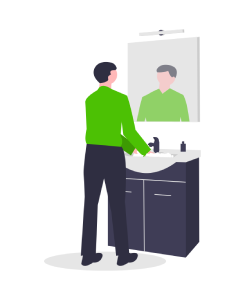
Dress for success
The last thing you want to do, is fall into the trap of rolling out of bed, and grabbing your laptop and sitting in your PJ’s all day. There’s a number of reasons for that, besides the lack of hygiene. There have been a number of scientific studies have proven that “people who dress up obtained more profitable deals” and “wearing business attire increased abstract thinking”. Overall, there is just a sense of pride and productivity when you are better dressed for work.
Just because you no longer have that commute, doesn’t mean you should skip the basics. Actually, given you have more time on your hands, why not add some extra exercise or relaxation before you start your work day?
Sure, you can wear more casual clothing, however think of it this way; should there be a last minute video call with your best customer, are you appropriately dressed to answer right now? Maybe that could be your baseline. I know, probably not the first of my remote work tips that you want to hear.
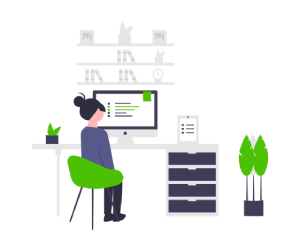
Have a good workspace
There are three main things to consider when choosing a workspace to work from. This is different obviously, if you are only working for a few hours at a café, because you can be far more flexible, however if you plan to work long hours or whole days from home, you want to consider three things;
- Boundaries
- Ergonomics
- Suitable tools
It’s often the easiest to sit at the dining table or on the couch to work, however that is often not the most ideal. So let’s go through these three points when choosing a suitable place to work at home.
Boundaries
You need to try and find a place at home that you can mentally switch off when you “leave work” for the day. If you are lucky enough to have a spare room, you can literally walk out of it, close the door, and forget about work until the following day. Seriously, this is one of the most important remote work tips I have. There's nothing worse than getting into bad habits with this.
However, if you don’t have the luck of a spare room, you may need to improvise. At absolute worst, you could use the dining table or another table, however you need to be clear with those around you that you are at work when you are sitting there with your laptop or equipment.
See my point about no distractions, later in this article.
Ergonomics
A dining chair is normally one of the worst things to sit on for extended periods of time. Sure, they may be comfortable for a meal, however for long periods of sedentary work, they are going to play havoc on your body. This goes for the couch as well; these are typically also a no-no, ergonomically.
Ideally you sit on a chair that allows you to adjust the height and tilt. You should be able to sit with your back against the chair, and have your feet firmly placed flat on the floor. In this position, the top of your laptop or computer screen should be at or slightly below eye level.
See the diagram below, or for more information, this handy guide from Worksafe Queensland may help.
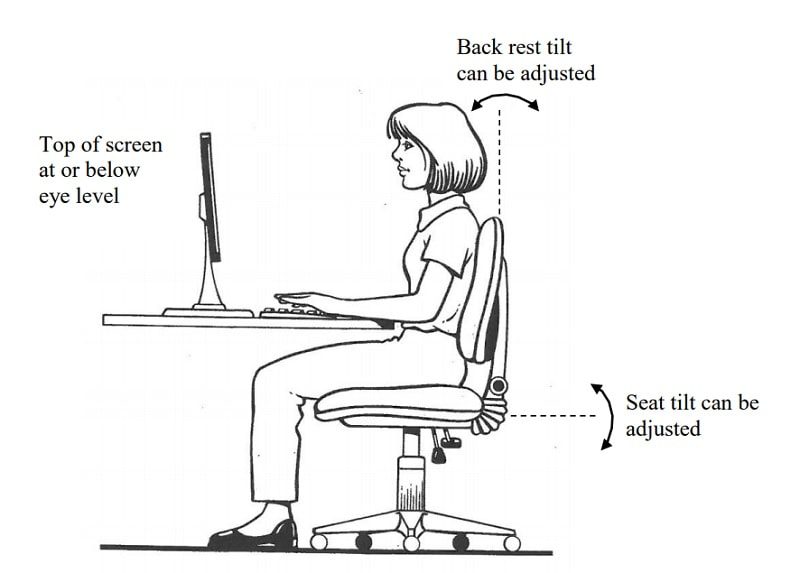
Image: Worksafe Queensland
Suitable tools
When I talk about “tools” for most of us that means software. Thanks to modern software deployment practices, most of your tools are likely to be cloud based anyway, which makes it easier to access, no matter whether you are at home, or the office.
However, should you have locally installed software, and don’t have a license for home, speak to the distributor first. There are programs from a number of software providers that allow a second copy to be used at home for a fraction of the cost of another license.
If you do need new software, such as video conferencing, or team management tools, then this detailed list of remote team tools will provide you with a great starting point.
BONUS: The Australian Tax Office is offering a simplified calculation method of claiming the costs of working from home. Here is more detail about that.

Stick to routine
This is one of those remote work tips I learned through error. I started working from home, and enjoyed the flexibility of being able to stop for social contact in the middle of the day (sometimes a game of golf, sometimes lunch at the pub). However, then I felt the need to make up my hours in the evening. Then, since I had worked late, I then go up later than normal.
You can imagine the cycle I ended up in, many years ago. The blurring between work and life can happen quickly, and you end up finding yourself answering emails at 2.00am, or waking up late mornings, and missing an important call.
The absolutely best thing you can do for both your own health and sanity, as well as your manager and colleagues, is to get into a good routine and stick to it, religiously.
Speaking of sleep, make sure that you get enough of it. Results from the world's largest sleep study have shown that people who sleep 7 - 8 hours per night on average, performed better cognitively than those who slept less, or more, than this amount.
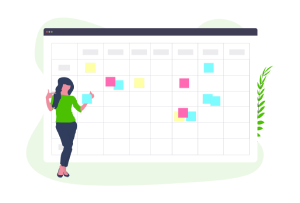
Know your own rhythm
Just because I am saying stick to a routine, it doesn’t mean I am advocating for the old boring 9-5. We all have different body clocks, and what works for some doesn’t work for others. For example, I prefer working at 6.00am than 8.00pm. I know others who dread the idea of any work before their third coffee at 10.
Having said that, be cognisant that others may be more 9-5 types, particularly your clients. This is made even more challenging if you have people or customers in multiple time zones. Over my recent 9 week isolation period, I spoke to people in 8 different countries by video conference, meaning I had a number of late nights and early mornings. Western Australia is often the challenging time zone at +8 hours.
There’s some great points in this article about flexible work hours that help set the picture here.

Daily planning
Just because you are working in a different location, that doesn’t mean you should throw your usual daily planning out the window. It is important that you use whatever method and processes you were, when back in your typical workspace.
Where possible, you should be able to use those same cloud based software planning tools that you used, or the typical to do list on paper or in a Word document; whatever you previously used.
It is really important to keep that list of priorities or tasks going, when working remotely, as there is obviously additional temptation to slack off. This list will help you keep focus and ensure you get everything done in due course.
Tools such as Asana and others allow projects and tasks to be managed in the browser, and the whole team can access them from anywhere.

No distractions
One of the most important remote work tips in this list, is avoiding distractions. These come from all directions; it could be those who live in the house with you, or it could be your entertainment system begging for your attention.
You're going to have to teach your family or housemates what it means when you are sitting at your workspace, with laptop in front of you. It is best to explain that this is a changing time at the moment and that you don't have as much flexibility as it looks like, and that you should be treated as if you were at the office.
Ideally, without distractions, you should be more productive at your home office than in the real office, because you are avoiding those inter office chats, etc. It is all down to how you clearly communicate this, and stick to it, with the people that are around you, or that drop in unannounced because they think you’re free for social visits.
This also applies equally for social media. You may want to ensure that you log out of all social media on your laptop or computer, and that you turn off all notifications for similar apps on your phone. Even better, close your email, if you can, for a few hours each day to ensure you get your priorities done.
Speaking of mobile phones, don’t use it. Your mobile can easily become your biggest distraction of all time. This is obviously based on your work, however if you only use your mobile for personal calls, etc. than you need to decide if it even needs to be in the same room at all.
Netflix, television and computer games are also huge distractions. If you have them on your laptop, promise yourself not to open them during work hours. If your TV is nearby, don’t turn it on at all, even for ‘background noise’. If you can, use a stereo or Google Mini, etc. to stream a music streaming station, instead of something that involves visuals.

Have boundaries
You absolutely must create and stick to some boundaries between not only your family, but your colleagues and clients. If you are working at 11pm, whatever you do, don’t hit send on a bunch of emails to clients at that time. It teaches them that you’re available in the late evening. You would be better to save them as drafts and send them in the morning.
This applies for those who like to just drop past your home with no notice. Make it a practice to either ignore the door, or open it and point out that now is not a good time. They will eventually get the hint, or you can be more forthcoming and explain it is work time. If you are to subtle for that, perhaps send them these remote work tips, and let them find out themselves.
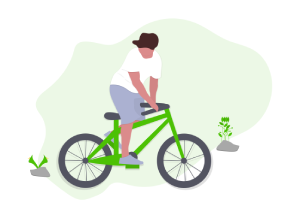
Take breaks
It is really important for both your physical and mental health that you get in a good habit of taking breaks. From day one, do not let yourself fall into the trap of eating over your keyboard, or at your desk.
If you are working from home, you have a kitchen nearby, so make something healthy for yourself and if the weather is good, sit outside. At least, sit somewhere away from the home office, so you keep up those barriers between work and life.
Speaking of something healthy, I have caught myself falling in the trap of eating junk each day. I now plan my lunch the night before when working at home, so I know what to prepare in the morning, and avoid grabbing something less healthy.
Whatever you do, do not just sit inside in the dark, or at your desk. It is important for you mentally and physically to get some sunshine and movement in.
If you are one of those people who can sit down and become absorbed in what they are doing, and spend 5 hours straight at your desk – stop! That’s no good for your back or your eye sight. Maybe investigate using a formal system such as the Pomodoro Technique, or even just buy a cheap kitchen timer (not your phone), and set it for a 5-10 minute break every 1-2 hours at least.
You can stand at your desk and stretch, or go have a coffee or grab another glass of water. Whatever it is, give our eyes a rest from the screen for a few minutes.
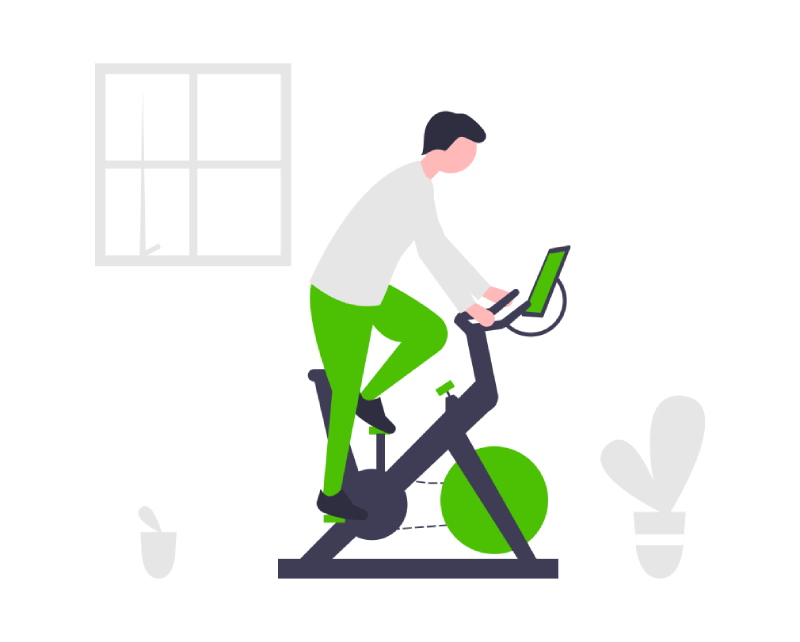
Regular movement
I wear an Apple Watch, which reports to me each day how I have gone standing, exercising and walking. I’ve found personally, that it is very easy to fall into a trap at home, and that I can easily end up doing 25% of the steps I would do, if I were at the office.
What works for me is going for a 20 minute walk of the neighbourhood during either a break or at lunch, depending on the weather. If I have an internal meeting, I can even use that time to walk and talk, or alternatively, I can listen to a podcast and get steps in at the same time.
I have friends who swear by early morning workouts, and studies show that your focus is improved if you exercise before work. If you miss the gym, then here’s a great list of video tutorials for 10 minute workouts you can do anywhere.
You don’t have to go that formal though; it could literally be a quick walk around the house every hour, a walk around the block before and after work, or maybe 30 minutes of Yoga in your lounge room. Whatever you do, make it a habit and stick to it.
Moving your body regularly is something that will keep your body and your mind, feeling good. The endorphins and oxygen are great for you, so set aside that daily time.
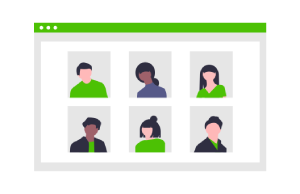
Over-communicate
One of the biggest issues with remote teams or remote work, is lack of interpersonal communication. Particularly when you are busy, it is very easy to fall into a trap of never being in contact with your colleagues. Because you can’t turn your head and see your team mates, you need to make more of a conscious effort to see them.
When we had the office closed for a month recently, we used Slack every day to communicate, like we typically do at the office, and then at least once week, the whole team jumped on a Zoom meeting, so we could actually see each other face to face. It is amazing how much information is conveyed in facial expressions and the like.
Many remote teams make a proactive effort to do a daily ‘stand up’ meeting via video each morning. Some teams, because they cross many time zones, tend to only hold one a week. Whatever you do, you should have options of voice, text chat and face to face video. Not only that, explain what each is used for.
For example, we use emails to keep track of important decisions or tasks. We use Slack (text chat) for idle chit chat and status updates. We use video calls for meetings with clients or in-house planning and status meetings. If everyone is on the same page about how you use each platform, it makes communication far easier.
I recommend that you practice video conference calls before you take any. If you have never taken a video conference call or at least you don't do it very often especially at home because you are typically available for meetings in the office you're going to want to know how you're being perceived.
Test the lighting test the audio find a place to sit. Every time you take a call that is your designated place to take the call. You do not want the camera shooting up your nose you do not want your kids playing in the background being distracting. As much as possible you need to control the environment people see when they are on a call with you.

Have a water cooler
This sounds like one of the weirdest remote work tips, but what I am talking about is that social contact among work colleagues. A virtual water cooler is very important for what they call ambient awareness; the little snippets of information you pick up in the office hallways which actually help you in your job.
Remember when you work in the office, you have co-workers pass by your desk and chat, or you gather at the coffee machine for a quick word? Those moments are important for both team building, as well as small information sharing sessions. If you use a text chat tool, such as Slack, then perhaps create a channel called Water Cooler for exactly this purpose.
If you prefer, set a reminder each day to check in with a colleague and rotate through your team. Get them on the phone or a video call, and informally check in with them.
You're going to save a lot of time each day from annoying chats, but you still need those social contacts. Set aside a little time and see how it pays off with you communicating with the people that often interact with you at the office.

Keep a social life
This is important, irrespective of pandemic lockdowns or not. Going back to the routine tip above, if you forget about social contact and you work from home, you’ll soon go weeks without seeing anyone but your partner, children or pets, if you have any.
This social isolation can be really unhealthy mentally for you, and means that you won’t be on top of your game for everything, including work. So yes, socialising actually affects your productivity.
In my recent isolation time, I arranged a time with friends to have a virtual “chat at the pub” using video conferencing. Four of us connected via our own homes, and we shared stories and laughs. It really helped me feel connected to the world, after weeks of no seeing more than a handful of people.
In Summary
I hope you found the above dozen remote work tips helpful, no matter your situation. If you are home, isolating for health reasons, then I hope you and your family stay safe. If you are trying out remote work life, then I wish you all the best in adopting a new way to work.
In summary, those remote work tips again, are;
- Dress for success
- Have a good workspace
- Stick to routine
- Know your own rhythm
- Daily planning
- No distractions
- Have boundaries
- Take breaks
- Regular movement
- Over-communicate
- Have a water cooler
- Keep a social life
All the best with your remote work, and thank you for reading!


